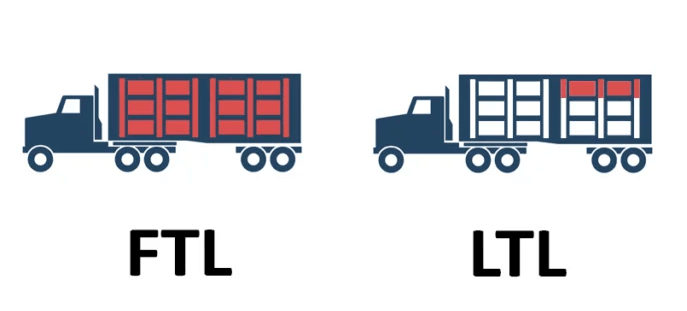LTL shipping and FTL shipping are two common ways to transport your cargo on the ground. It is important to know these two shipping modes so that you can choose the more cost-effective way for your business.
Here is some basic information about FTL and LTL shipping. Let’s take a look.
What is LTL shipping?
The full form of LTL in logistics means less-than-truckload. It means several small shipments are combined into a whole truckload of goods and shipped together. Specifically, freight forwarders collect these small shipments from several suppliers, which are shipped together in the same truck. When these cargoes arrive at the destination cities, they are sorted into original individual cargo and delivered to the different final places.
This shipping mode maximizes the transportation space of trucks, which is very friendly to those small and medium-sized businesses because they pay for as much freight as they use truck space. It’s a bargain.
LTL shipping is like sharing a ride when you use Uber, the driver will stop to pick up other passengers along the way, and sometimes he may take a detour. Although this shipping mode is cheap, the time you arrive at the destination is often longer than expected, which can not guarantee punctual delivery.
What is FTL shipping?
FTL means full truckload in logistics. It refers to a scenario in which you book a whole truck rather than sharing it with others, which is ideal for large shipments. FTL works on a point-to-point distribution model. It is the movement of goods from one shipper to a single destination without stopping. It’s time-saving.
This shipping mode is like choosing a tailored taxi service. The driver will pick you up and take you directly to your destination. Generally, you can arrive according to the estimated delivery time, but the cost is much more expensive than carpooling.
Both methods use pallets to transport goods on roadways. However, some LTL carriers do use intermodal rail shipping.
What is the difference between LTL and FTL freight?

Image Source: geekseller.com
The main differences between FTL and LTL shipments are four aspects.
Cargo weight
Choosing which shipping mode to load your cargo is determined by your cargo weight. Typically, LTL shipments are smaller weighing between 100 to 10,000 pounds. While FTL shipments tend to be much larger, often weighing 20,000 pounds or more.
Time
FTL shipping offers a much faster shipping speed than LTL shipping. The truck goes from point A to B without any other pickups. But LTL shipping involves freight consolidation, which means your cargo may be handled and transshipped with others many times before arriving at your door. It’s time-consuming.
Cost
For FTL shipping, you need to pay for using the entire truck for your cargo. But when you choose LTL to ship your small volume of cargo, for example, three pallets at a time, you only need to pay for the space you are using instead of the total truck capacity. It is cheaper.
As for many small and middle-sized Amazon FBA sellers, LTL is a common option besides express like UPS, used to deliver shipments to the FBA warehouse once cargo arrives and finishes customs clearance at the destination port.
If you want to know local LTL and FTL freight and rates, you can ask your shipping agent.
Safety of goods
For fragile goods such as glass, the risk of goods damage caused by FTL shipment is lower than that of LTL. Because your goods will always stay in the same truck and will not be transferred many times. LTL shipping may convert trucks or transfer many times before shipment, thus increasing the risk of goods damage or loss. Therefore, good packaging is very important in LTL shipping.
LTL vs. FTL: how to choose?
Both FTL and LTL have their own advantages. Choosing which shipping mode may vary from situation to situation. You should consider the cargo weight, safety, arrival time and budget.
If you need to ship a batch of small and durable goods with no requirements for delivery time, LTL shipping can save costs.
If you have a large number of fragile goods and must receive them on time, FTL shipping is more suitable for you.
We are JingSourcing, a leading sourcing company in China. We have helped 4,000+ importers source various goods from China and arrange different shipping plans for them. We have lots of long-term cooperative shipping agents with competitive prices and can provide tailored shipping solutions for you, which are not limited to LTL or FTL shipping. In addition, one-by-one quality control is available if you need it.
Get Flexible Shipping Solutions
- Real-time freight rates
- Most competitive quote

